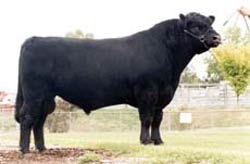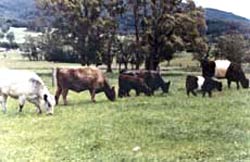
Cattle breeds: Galloway
Origin and history

The Galloway breed is a very old Scottish breed. It is the oldest known British breed on record, and the oldest known polled beef breed in the world. Galloways can be found all over the British Isles as well as in many countries around the world, including Australia, New Zealand, Canada, USA, Germany, Austria, France, Denmark and South Africa.
The earliest evidence of the Galloway breed in Australia dates back to 1858. However, it wasn’t until 1951 that a registering body was formed. The Australian Galloway Association was incorporated to provide a proactive organisation which assisted breeders of Galloways, Belted Galloways, White Galloways and Miniature Galloways to register, transfer and promote their cattle.
The Galloway Cattle and Beef Marketing Association Inc. was formed in 1997.
Breed characteristics

- Galloways can be black, dun or red.
- Belted Galloways are black, dun or red with a white belt entirely surrounding the girth of the animal, without any breaks.
- White Galloways are white in colour with black, dun or red points (ears, nose, feet).
- Miniature Galloways have the same breed characteristics as Galloways but must comply to strict height requirements. They are available as Solids, Belted or White.
- Galloways are naturally polled. They are long-living, very resistant to disease, and easy to manage.
- They create strong hybrid vigour due to the purity of the breed.
- The unique double coat of hair makes the Galloway an extremely versatile breed, able to withstand extremes of temperature and climate. According to research done at Montana State University, a beef animal which has a hair coat that is thicker by just 2.5 cm (1 inch) would need between 20% and 25% less ‘digestible feed intake’ to maintain body weight when the weather is cold. Galloways, because of their extra hair, can actually gain weight when on the same ration as other cattle who are losing weight.
- Galloways have an amazing ability to forage on sparse hill conditions, yet also perform outstandingly on high-grade pasture. In Germany, Galloways are being sought after to improve marginal lands, as they graze non-selectively. Non-selective grazing encourages the better quality grasses, while at the same time does not allow the poorer quality species to take over.
- With the Galloway’s non-selective grazing habits, Galloway beef can be raised under extensive conditions. In USA, Canada and Switzerland, there has been research carried out that shows that beef which is extensively produced can be of great benefit in a healthy diet. Galloway beef is rich in linoleic acid, which reduces the dangerous type of cholesterol (LDL), prevents thrombosis and therefore protects coronary vessels.
- The carcase of the Galloway is of excellent quality, with high yields. By using Galloways and their crosses it is easy to obtain fat cover and heavy muscling to suit most trade requirements and new marketing techniques. Galloway steers have gained much success in both carcase competitions and grazing trials. The high yield of Galloway and Galloway cross steers makes them a very attractive item for the feedlots, as the higher the yield, the higher the profit per animal.
- One of the most notable characteristics of the Galloway female is her ability to rear calves naturally under all conditions. In Australia, the Galloway has proven itself not only in cold climates, but also in the hot inland, where Galloway cross cows have survived severe droughts while rearing a healthy calf.
- Galloways are an extremely fertile breed, regularly producing vigorous live calves. The cow is noted for ease of calving, being a protective mother, and having an abundant supply of milk. A sustained lactation period ensures a strong, well-nourished calf at weaning. The maternal attributes of the Galloway cow come out tops in a study at the famous Clay Animal Research Center, Nebraska, USA. Eleven breed groups were tested for their ability to give birth and rear their calves. Of the 11 breed groups included in the study, the Galloways recorded the highest weaning percentage (95.5%), the highest calf survival percentage (95.2%), and an outstandingly low incidence of calving difficulty (0.8%).
Further information
Further information on Galloways, Belted Galloways, White Galloways and Miniature Galloways can be obtained by contacting:
Australian Galloway Association Inc.
PO Box 42
Westbury TAS 7303
Ph/Fax: 03 6393 2866
Website: www.galloway.asn.au
The Galloway Cattle and Beef Marketing Association
PO Box 309
Hall ACT 2618
Ph: (02) 6230 2536
Fax: (02) 6230 9336
Website: www.gallowaycattle.com.au
Australian Belted Galloway Association
PO Box 189
Kiama NSW 2533
Ph: (02) 4232 3333
Fax: (02) 4232 3350
Website: www.beltedgalloway.org.au
Acknowledgment
This Agfact is based on information supplied by the Australian Galloway Association Inc. Their contribution is gratefully acknowledged.

